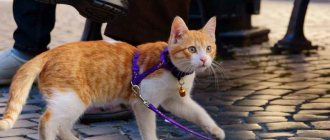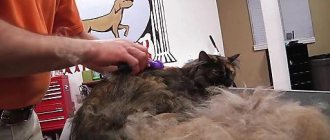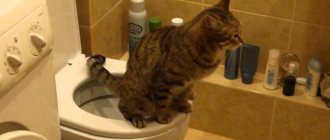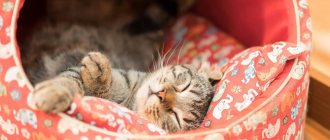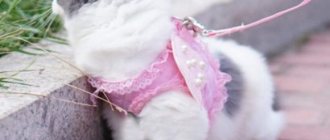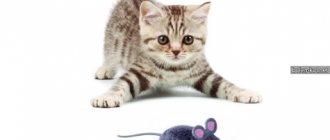Cats are playful and active animals, and most of them love to frolic outside. But what to do if pets live in an apartment, and the owners are afraid to let them out into the yard for a walk? In this case, harnesses for cats will come to the rescue, which today can be bought at any pet store. A cat leash is called a harness; you can use it to walk your pet without fear that it will get lost. This not only ensures the safety of the pet, but also provides peace of mind to the owner. What types of harnesses are there? How to choose them correctly and put them on your furry pet? How should you teach them and what is important to take into account? We will consider these and other questions.
What types of harnesses are there?
Even if your pet is exclusively domestic, he still needs fresh air and walks in nature. But not a single loving owner will let his furry friend go outside alone, because there are dangers lurking for the pet there in the form of dogs, vehicles, etc. Or the cat may simply get scared and get lost.
And harnesses for cats will serve as an excellent solution, because thanks to this convenient product the pet will be under the supervision of the owner and feel free. And although you can now buy harnesses of any color and size, you should not buy the first model you come across. First you need to understand what type of cat leash is right for your pet. Today, four of their varieties are most popular.
- Eight.
This design is made in the form of two loops that are attached to the animal’s neck and behind the front legs. Such a device covers the body tightly enough, preventing the pet from freeing itself from it. - Type "N".
This product is almost an analogue of the previous one, with the only difference being that two loops on the back are connected into a bar. As a result, such a harness looks like the letter “H”. - Type "V".
Similar to the first types, only the loops are connected on the chest with the letter “V”. - Harness-jacket.
A denser variety is not just loops, but a product made in the form of a jacket. This design will protect your pet’s fur from dirt and the body from the cold. The harness-jacket is considered a fashionable model and is already included in the category of clothing.
How to choose a harness for a cat?
After you come to the pet store, do not rush to immediately buy the harness that you like, because it may not suit your pet in size or according to any other criteria. It’s better, of course, if your pet is with you so that you can try it on. It is necessary to choose a harness taking into account the following nuances:
- The material from which the harness is made is of no small importance. It is best to purchase a product made of nylon or cotton - they do not chafe and are easy to clean. Leather harnesses are not particularly in demand because they are quite heavy and rigid.
- Measure the width of the straps; it should not exceed one and a half centimeters. Excessively narrow straps will put pressure on the animal’s skin, and too wide ones can impede movement.
- Check the fastenings, they should be easy to fasten and unfasten, the durability of the harness depends on this. Make sure there is a piece to attach the leash.
- The size is determined as follows: put the harness on your pet and insert two fingers between the product and the animal’s back. If your fingers fit freely, then this size is right for you. Keep in mind that the leash will pull on the harness, so a reserve is needed.
If you do not have the opportunity to take your pet to the pet store, then agree with the seller about a possible exchange of the harness. There should be no problems with this, since everyone understands that any item purchased without trying on may not be suitable.
Bright vest for a cat (diagram)
Such a bright vest can be knitted for a cat from leftover yarn. We couldn’t find a pattern, so we had to draw it ourselves. This vest begins to be knitted from the collar.
Legend:
1. – neck circumference; 2. – gate height; 3. – chest circumference + 4 cm; 4. – back width – ⅔ chest circumference (measurement 3) – ⅓ foreleg circumference. 5. – armhole depth – ⅙ of the circumference of the front paw. 6. – armhole height – ⅓ of the circumference of the front paw. 8. – distance from the base of the neck to the middle of the abdomen. 9. – back length. 10. – ⅙ chest circumference (measurement 3). 11. – distance from the base of the neck to the front paw.
We knitted the collar, and began to add loops from the collar to the armholes. The increase should be 3 times. That is, we add 6-8 loops. It is more convenient to knit the middle of the vest, where the armholes are, from 3 balls. In the photo, the vest is one-piece, but we have the same model, only with a fastener between the armholes with buttons or Velcro.
We tie it to the middle of the belly, and begin to smoothly decrease the loops. We knit to the end of the back and close the loops. If you make edging for the armholes, then the girth of the front paw is increased by 3-5 cm. For sleeves and edging at the bottom, you can raise the loops, or tie 1.5 cm strips and sew them to the bottom and armholes. That's all, the product is ready. Sew buttons or Velcro on the bottom of the vest.
Another similar pattern for knitting a vest for a cat. The diagram is given for three sizes, indicated in inches (1 inch = 2.5 cm). That is, the required numbers must be multiplied by 2.5.
Advantages and disadvantages of harnesses
Like any design, harnesses also have their pros and cons. What are their advantages?
- The ability to safely walk your furry friend in the fresh air.
- Absolute control over your pet during a walk, be it in the yard or on a trip out of town.
- It is very convenient to visit the veterinarian without keeping the animal in a cage all the time. And also transport your pet on the train, take it to the country, go on a visit and much more.
- The roulette leash allows you to expand the scope of your walk by adjusting the distance.
Now about the cons. They are minor and can easily be avoided if desired.
- Be prepared for the fact that the cat will not immediately accept the harness; the first reaction will be fear.
- At first, the pet will begin to struggle and twitch, so it will need to be trained.
- It happens that cats break out of their harness and run away. This is why it is important to buy a quality product. The same goes for the quality of the leash to the harness.
- If the cat has gained weight, you will have to buy a new product; the old one will weigh on him.
Getting your cat used to wearing a neck
It is better to put this item on quickly. This will cause less irritation to the animal. Start fastening from the neck, and then move on to the fastening on the body. Veterinarians advise teaching pets to wear a harness from an early age. This way, addiction will occur faster.
Use homemade pet collars for walks. If desired, they can be decorated with beautiful stones, beads or rhinestones. This way they will be brighter and more beautiful. And in winter, the harness-vest will even serve as an additional warming element for your pet.
Which harness should you prefer?
As a rule, a leash usually comes complete with a harness; it is attached to a special ring and has a length of at least two meters. But if you wish, you can purchase a leash of different lengths, or simply buy it separately in the form of a tape measure. This way you can easily adjust the length, because you never know how the animal will behave. This option is very convenient and compact, easily rolled up and does not injure the pet. This is especially true if you choose a harness in the form of a vest, which is initially equipped with fasteners. Just keep in mind that although this model is reliable, it will be hot for the cat in sunny weather, especially if the animal is too fluffy.
Also, owners of cats and cats today are offered a variety of products, the emphasis of which is not only on the convenience and comfort of pets, but also on fashion. Pet stores now have a huge selection of amazingly beautiful harnesses: with rhinestones, ornaments, stripes, patterns and other decorations. They are mainly purchased by animal owners whose pets participate in exhibitions in order to present their pet in the most favorable light. But some owners buy such elaborate products simply because for them a cat is not just a domestic creature, but a true, loyal friend.
White vest for exhibition
This elegant vest is suitable for an exhibition or for a visit to the doctor.
To work you will need:
- White yarn (80% wool, 20% acrylic)
- Knitting needles 4 mm.
- Hook 3 mm.
- Buttons.
Main pattern: stockinette stitch and pattern according to scheme 1. Knitting density: 20 loops/20 rows = 10/10 cm.
Cast on 64 loops on the knitting needles, knit 2 rows with stockinette stitch, and divide the work into 3 parts: 2 side parts of 26 loops each, and the middle one - 12 loops.
Right part (26 loops): start with the edge stitch, knit stitch, pattern according to scheme 1. Knit to a height of 9 cm and remove the loops on an auxiliary needle. Left part: we knit the same way, but in a mirror image. Middle part: knit with stockinette stitch to a height of 9 cm. Then we connect all the loops into one fabric and continue knitting with the same patterns to a height equal to 18 cm. After 28 cm from the edge we switch to 3/3 elastic, knit 3 cm with elastic, close the loops . We make a collar: we cast on 42 loops along the edge of the vest and knit with an elastic band 3/3 by 12 cm in height. We close all the loops not very tightly.
Product assembly
on the right side of the back we knit the bar of 4 rows of dc, making buttonholes at the same distance from each other. We make loops like this: instead of 2 dc we knit 2 ch). We tie the armholes 4 r. SSN.
How to properly put a harness on a cat?
So, you purchased a harness for the first time, and now you are faced with the question: how to properly put a harness on a cat? At first, out of habit, it will be difficult for both you and your pet, but show maximum patience - and everything will work out. After all, a new product for a cat is an incomprehensible thing, and at first he will probably break free and try to escape. You should put the harness on the animal in stages, following the following instructions:
- Place the harness next to your pet - let him smell it, play with it and make sure that this previously unfamiliar design is not dangerous and will not cause him any harm.
- Take your pet in your arms, pet it, calm it down and talk to it tenderly.
- Then start putting on the harness. Place one loop around the neck with the carbine up (it should be on the back), and insert the animal’s paws into the second loop. If you bought a model with a clasp, then in this case the cat's paws are inserted into the loops one by one, the strap is adjusted under the belly, and the clasp is secured on the back.
- Check that you have not twisted anything and that everything is securely fastened. Make sure the harness does not put pressure on your pet's skin and adjust the straps if necessary.
- Fasten the leash to the carabiner ring - and the job is done, you can go for a walk.
If you have difficulty putting on a harness, you can use the Internet by searching for “how to put a harness on a cat video” and watch the instructions.
New Year's outfit for a cat
You can buy a festive outfit for a pet, but it is expensive and not always affordable for the owners. Therefore, many people prefer to sew clothes for a cat with their own hands, especially when everyone’s favorite New Year is coming. Remnants of fabric or old clothes will do for sewing. To do this, it is important to take the correct measurements and use a pattern. It is carefully transferred to the material. It is ideal to have a sewing machine on hand. But you can sew the outfit by hand. The main thing is that the overalls fit comfortably on the cat and do not cause discomfort. Girls can have frilly skirts. It is also worth making an elegant cap.
How to accustom your pet to a harness?
But putting an unfamiliar product on your pet is only half the battle. Next, the acute question arises: how to accustom a cat to a harness? It is rare for an animal to calmly accept a previously unseen item and obediently allow itself to be walked in it. Therefore, she will need to be accustomed to the new design. It is best to do this without waiting for the pet to become an adult; the most optimal age is from six months to a year. You can start earlier, from three months, but without walking for now, and so that the kitten gets used to the harness gradually. In any case, you should not immediately put an unfamiliar object on your pet; the animal must first “get to know” it, sniff it and play. After this, the harness must be placed in the pet’s favorite places: near the food bowl, next to the sleeping area, etc. The cat will gradually get used to it and after a few days the harness can be put on, but without a leash - let the animal just walk around in it at first.
Some immediately perceive a foreign object on themselves calmly, others will try to remove it - it depends on the character of the pet. If he does not immediately accept the harness, then you need to distract him with something, some tasty food or a laser pointer. But not without fanaticism, 5-10 minutes will be enough for a start. It is recommended to repeat such exercises several times, and it is better before meals, so that the pet associates the harness with something pleasant. When you notice that the cat no longer pays attention to the structure put on it and behaves freely, then you can already fasten the leash and pull it slightly. But don’t get carried away and pull the cat unnecessarily - it will probably put its paws on the floor and begin to resist. Do what the animal wants: stand next to him, follow him, just be present. The pet will soon get used to it, and it will be possible to go outside.
When not to use a harness
Owners who love their pets can fork out for the most expensive accessory for them, or spend more than one hour creating an exclusive and one-of-a-kind walking device, watching dozens of master classes. But in order not to waste time and money, you should know in which cases the use of a harness is not recommended:
- It is better to walk cats over 10 years old who have not previously been accustomed to a leash without one, in uncrowded places;
- pregnant, unvaccinated or weak pets who have undergone surgery or illness have a high risk of catching the virus from street animals;
- in children whose immunity has not developed, such an experience can worsen their health;
- For an overly timid cat, using a harness will result in considerable stress, and for an aggressive cat, it will also result in unnecessary injuries.
The first time a cat in a harness goes outside
Before we consider the question of how a cat's first walk should go, let's pay attention to four important reasons why pets should not be walked in a harness at all. Otherwise, nothing good will come of it.
- Kittens up to six months old. These little ones still have weak immunity and they can’t go outside yet.
- Older cats who have never seen the street before. Don't risk their health.
- Postoperative or postpartum period. The animal's body is not yet strong.
- Character traits. If your pet is overly aggressive or cowardly.
If your cat does not fall under any of these points, then you can begin to accustom your pet to the street. To begin with, choose some quiet courtyard, where there will be no large crowds of people and animals. The more secluded the place, the better. If there is no such place nearby, then it is better to carry the animal in your arms to the nearest public garden. There, carefully lower your pet to the ground and observe its behavior. In a new place, and even in an open space, the cat will behave warily and look around in fear. Don't bother her, let her look around and get used to it. Make sure that nothing scares her, otherwise this will discourage the animal from wanting to go for walks for a long time. Don't try to put pressure on your cat and force it to walk, you must follow it yourself. You must come to terms with the fact that it is your pet who is walking you, not you. Be patient, time will pass - and walks in the fresh air will begin to give him pleasure.
Cat leash: purpose and types
Even if the cat does not walk outside, it is still worth purchasing a leash. This accessory may be needed during out-of-town trips, to participate in exhibitions, and also when visiting a veterinary clinic. A harness and leash will protect the cat and also provide peace of mind to the owner of the animal.
There can be two types of leash for cats:
- Roulette. An excellent choice for kittens who are just starting to get used to the outdoors. The tape measure is also suitable for walking an adult animal. There are tape measures with limiters.
- Belt of a certain length. The length is selected based on the activity of the pet.
How to make a harness for your pet yourself?
If for some reason you don’t have the opportunity to buy a harness, or you didn’t find the right size at the pet store, or you just like to do handicrafts, then you can make this useful accessory with your own hands. Knitting lovers can simply knit a product from threads or yarn (depending on the season), and those who love to sew can build a harness from any available material. Denim is ideal; it is soft, comfortable, durable and breathable. The main thing is to take the measurements correctly, remembering to place your finger so that the finished harness does not put pressure on your pet’s skin.
After this, you should cut out the necessary elements, leaving space for the seams, and connect them together. You can also make a leash with your own hands; there are several ways to do this, with and without rivets. A more detailed master class can always be found in abundance on the Internet. You will need the following tools: a thick “gypsy” needle, strong and durable threads, a large button or clasp, a metal ring for a carabiner and, of course, suitable material. The latter is at your request; it can be not only denim, but also any other equally durable fabric, such as nylon or soft leather. As a result, you will receive an exclusive harness for your pet.
Taking measurements from a cat
To create a clothing pattern for cats, you will need to place the cat on the table. It is recommended to prevent it from being pulled out. This will help you take measurements correctly. She should stand with all her paws on the surface. Using a tape measure, measure the length from the tail to the withers. If you need to sew a jumpsuit with a hood, then it is recommended to measure the circumference of the head, as well as the length from the eyes to the neck.

